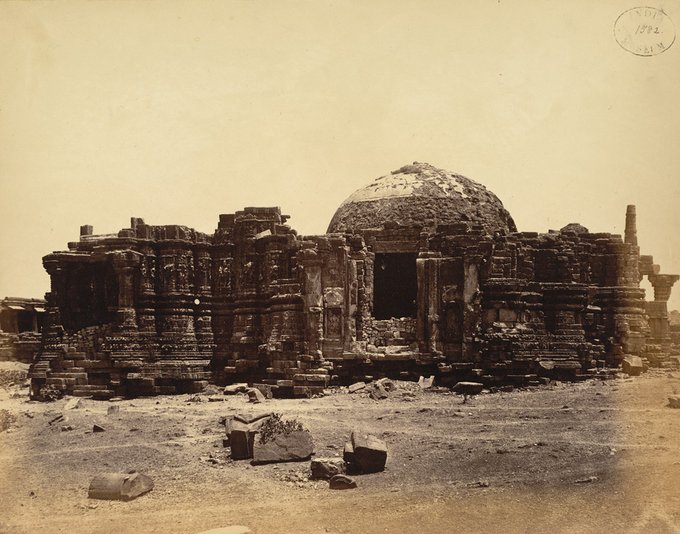For over two millennia, the sacred Somnath Temple in Gujarat has stood tall as a prominent place of pilgrimage for Hindus. It has remained a symbol of our spiritual and cultural heritage with roots deep in the sands of time. By the shore of the Arabian Sea, or what should be rightfully called the Sea of Saurashtra, it remains enshrined within one of Shiva’s most sacred jyotirlingas.
However, this temple has borne witness to immense storms of religious and fanatic violence. Its walls shattered and rebuilt through the long centuries.
The most infamous destruction was by Mahmud of Ghazni in 1026 CE, but the resilient Hindu spirit ensured Somnath survived to inspire generations.
Here’s a brief history of the fall and rise of the Somnath temple.
The Rise of The Somnath Temple

References to the existence of the Somnath Temple emerge from scriptures dating back to the 6th century BCE. However, the first physical construction of the temple likely occurred around 345 CE, during the reign of the Guhila king Jaya Singh, who built the first structure to house the jyotirlinga. Made of rich materials like gold, the original temple flourished as a prominent pilgrimage site under successive rulers.
For centuries, it remained a landmark of glory by the coast, until the armies of Mahmud of Ghazni brought the dark clouds of war upon its golden spires in 1025 CE, and its light was quenched in the first of many destructions it would face down the ages.
Mahmud’s invasion and destruction of the temple shook the local population.
The First Destruction by Mahmud of Ghazni in 1025 CE
Driven by the desire to spread Islam and plunder the fabled riches of India, Mahmud of Ghazni, the formidable Turkic ruler, launched a series of audacious military campaigns that would leave an indelible mark on the subcontinent’s history.
In 1025 CE, Mahmud’s insatiable thirst for conquest led him to the hallowed shores of Gujarat, where the Somnath Temple stood as a testament to the region’s rich cultural heritage.

The temple’s immense wealth, legendary even in distant lands, had long piqued Mahmud’s avarice. But it was not merely the allure of riches that fueled his determination to conquer Somnath. For Mahmud, a staunch believer in Islam, the destruction of this iconic Hindu sanctuary represented a symbolic triumph over a rival faith.
In his memoir Futuhat-i-Yaldizi, Persian historian Al-Utbi, who accompanied Mahmud on his campaign, provided graphic details of the atrocious scene. He wrote that 50,000 Hindus were slaughtered in the temple precincts alone. Mahmud had the jyotirlinga smashed with axes, severed the arms and noses of all sculptures, and razed the structure.
The attack sent shockwaves across India. Abul Fazl, a noted historian during Akbar’s reign, wrote in Akbarnama that Mahmud’s act “struck such terror into the Hindus that they did not dare to rebuild [Somnath] for a long time.”
Poet Kālidāsa expressed the collective Hindu trauma, lamenting “the destruction of that indestructible linga.“
Rebuilding and Repeated Destructions
The resilient Hindu spirit refused to let their sacred site remain desecrated. Within a few years, Somnath was rebuilt under local rulers. But repeated invasions ensured its destruction and reconstruction in a relentless cycle of destruction and rebirth.
In the 12th century, Muhammad Ghori sacked the temple. Alauddin Khilji followed suit in the early 1300s, taking away its gold and massacring thousands more. British historian Vincent Smith wrote that Khilji “carried away the gold plating of the linga, and destroyed the temple out of bigotry and fanaticism.“
The destruction continued under Tughlaq ruler Ahmad Shah in the 1400s. Renowned historian K.M. Munshi wrote of Ahmad Shah’s attack, “The temple was razed to the ground and a tower was erected on the site…to serve as a symbol of the triumph of Islam over Hinduism.“
Each time, under brave Hindu kings like the Solankis and Paramaras, Somnath rose from the ashes. But the invaders kept returning, unwilling to let the resilient symbol of Hinduism stand tall again.
The Modern Somnath Temple

It was only in the 20th century that Somnath got a structure befitting its ancient glory. Inaugurated by India’s first Home Minister Sardar Vallabhbhai Patel in 1950, it was built to resemble the original temple as far as possible based on literary evidence.
Patel had said during the inauguration, “For over 1,000 years, Somnath has been lying in ruins, but see, what a magnificent Temple has been reconstructed with the labor of love and devotion…I am happy that the rebuilding of the Somnath Temple has been done in such a magnificent manner.“
Today, the modern Somnath stands as a prominent pilgrimage site attracting millions annually. In a speech at the temple, Prime Minister Narendra Modi said, “Somnath is a symbol of India’s resilient spirit and cultural heritage. It shows that no matter how much destruction is caused by invaders, the underlying strength of our civilization is intact.“
Concluding The Somnath Saga
Somnath stands as a shining symbol of Hindu perseverance in protecting Dharma. No amount of destruction by invaders could break the Hindu character – Somnath was demolished but could never be demolished from the heart of every Hindu.
Its story of repeated destruction and reconstruction reflects the enduring significance of Somnath in Hinduism and the resilient spirit of Hindus that has kept their faith and heritage alive through centuries of adversity.





